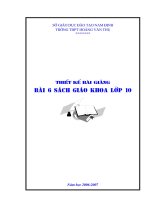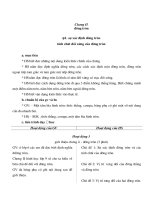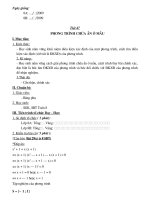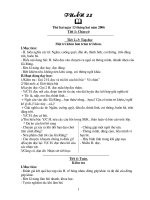Giáo án tham khảo lớp 6
Bạn đang xem bản rút gọn của tài liệu. Xem và tải ngay bản đầy đủ của tài liệu tại đây (109.99 KB, 3 trang )
Prepared date: July 10, 2013
Teaching date: July 15, 2013
Week: 15
Period: 43
Class:6A1
Material:English 6
UNIT 7 : YOUR HOUSE
Lesson 4 : IS YOUR HOUSE BIG? (B2 – B3)
Learner’s aspects
+ Characteristics: half a class is active, other is passive.
+ Language level: Secondary.
+ Background knowledge: Students have known vocabularies related to country and city.
+ Number of students: 35.
I. Objective :
1/ By the end of the lesson, students will be able to describe where they live.
2/ Language focus:
- Grammar:
S + V ( - s / - es )
S + do /does +NOT+V-inf
Do / does + S +V-inf ?
- Vocabulary:
+ lake / river
+ hospital / factory
+ bank / post offic
+supermarket / movie theatre
3/ Language skill: Grammar Translation Method
II. Teaching aids: Cassette and cards, book, board…
III. Procedure:
Time Content Teacher’s activities Students’ activities
5’
1.Warm up: B2, page 77
+Vocabulary:
- Noisy
- Quiet
- an aparment
- a market
- a zoo
- paddy field = rice paddy
Transformation Writing
- Ask Students to go to the
board and write down some
previous vocabularies that
they have learnt by heart
(about the town or country).
- Listen and write the
words about the town or
country and explain the
meaning of the words.
- Pay attention to the
teacher’s explanation.
8’
2 . Presentation: B4, page 77
Form:
* Affirmative : S + V ( - s / - es )
I live in the country.
He lives in the country.
* Negative : S + do /does +NOT+V-inf
I don’t live in the country.
He doesn’t live in the
country.
* Interrogative : Do / does + S +V-
inf ?
Do you live in the
country?
Does he live in the
country?
- Ask students to read model
sentences in B4 on page 77:
Do you live in town?
No, I live in the country.
Does he live in town?
No, he lives in the country.
- Ask students to retell the
form.
- Have them take notes after
retelling the three forms of
ordinary verbs in the Simple
Present tense.
- Explain the Structure and
how to use this structure then
translate the content of these
model sentences .
- Read model sentences
in B4 on page 77:
Do you live in town?
No, I live in the
country.
Does he live in town?
No, he lives in the
country.
- Retell the form.
- Take notes after
retelling the three forms
of ordinary verbs in the
Simple Present tense.
3. Practice:
- town / country
- house / apartment
- lake / river
- hospital / factory
- bank / post office
- supermarket / movie theatre.
Word cue drill
- Run through the cues.
- Hold up the first cues and
say the model sentences.
- Do you live in town ?
- No, I live in the country.
- Do you live near a lake?
- No, I live near a river.
- Correct their mistakes.
- Look at the cues.
- Listen to the teacher.
- Repeat it chorally and
then individually.
- Make the sentence for
themselves.
- Some pairs practice in
front of the class.
5’
4.Further practice: Find someone who
- Put the table on the
board.
- Get students to get into
groups.
- Get students to ask each
other questions.
+ Teacher: Do you live
in town?
+ Student (Lan): Yes, I
do.
- Correct if there are any
mistakes.
- Feedback.
- Look at the board.
- Work in groups.
- Stand up and ask each
orther questions. When
they find someone who
says “Yes” they fill in
the name. They can’t fill
in someone’s name more
than once.
- Tell the teacher what
they have found, e.g. “
Lan lives in town.
…………… ”.
5’
5.Homework:
- Facilities vocabulary.
- S + V ( - s / - es )
- S + do /does +NOT+V-inf
- Ask students to learn by
heart facilities vocabulary
with three forms of ordinary
verbs in the Simple Present
- Take notes and
memorize
- Do homework as the
teacher suggests.
Find someone
who lives…
Name
………in town? Lan
………in the country?
………near a lake?
………next to a market?
………opposite a paddy field?
………near a post office?
- Do / does + S +V-inf ?
- Unit 7: Your House – TOWN OR
COUNTRY? - Lesson 5 : C1-3.
tense.
- Have them prepare Unit 7 -
Lesson 5:(C1-C3): “How”
question and “by car / by
bus”.
***FEEDBACK :
- Advantages
• GTM focuses on sentence structure, grammar, vocabulary and direct translations of the native language
to English.
• Little time is spent dealing with the spoken form of the language. Paying attention to reading and
writing.
• Works well with large classes : The teachers can control and manage the whole class easily .
• The teachers become more active in their teaching because they try to help their students to
understand the content of lesson that he want to teach.
• The learners can read and understand the text quickly
- Disadvantages
• One of the major disadvantages of this method of teaching is that it leaves students frustrated and
bored. GTM is less paying attention to speaking, no intraction between teacher and students and
students and students, stressful environment, no creativity.
• Easily forgotten information .
• The students are only taught in context of lesson, not related to real life.
• The students depend on translation only with the vocabulary in lesson, with equivalents in the students'
mother tongue. They can not improve the best their speaking and listening ability because This method
focuses mainly on reading and writing and ignore communication (listening and speaking)









